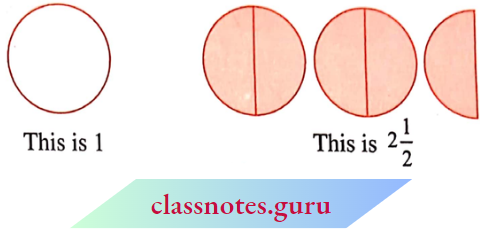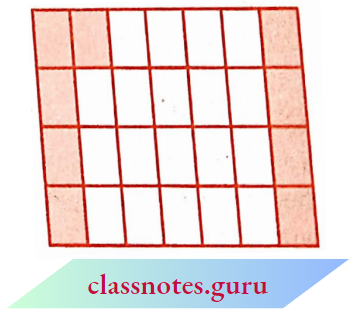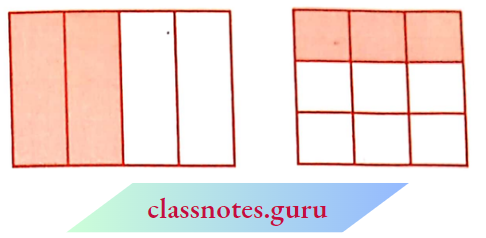NCERT Notes For Class 6 Maths Chapter 7 Fraction Introduction
Subhash had learnt about fractions in Classes 4 and 5, so whenever possible he would try to use fractions.
One occasion was when he forgot his lunch at home. His friend Farida invited him to share her lunch. She had five pooris in her lunch box.
So, Subhash and Farida took two pooris each. Then Farida made two equal halves of the fifth poori and gave one half to Subhash and took the other half herself. Thus, both Subhash and Farida had 2 full pooris and one-half poori.

Where do you come across situations with fractions in your life?
Subhash knew that one-half is written as \(\frac{1}{2}\) eating he further divided his half poori into two equal parts and asked Farida what fraction of the whole poori was that piece.
Read and Learn More NCERT Notes for Class 6 Maths
Without answering, Farida also divided her portion of the half puri into two equal parts and kept them beside Subhash’s shares.

She said that these four equal parts together make one whole. So, each equal part is one-fourth of one whole poori and 4 parts together will be \(\frac{4}{4}\) or 1 whole poori.
When they ate, they discussed what they had learnt earlier. Three parts out of 4 equal parts is \(\frac{3}{4}\).
Similarly, \(\frac{3}{7}\) is obtained when we divide a whole into seven equal parts and take three parts. For \(\frac{1}{8}\), we divide a whole into eight equal parts and take one part out of it.

Farida said that we have learnt that a fraction is a number representing part of a whole. The whole may be a single object or a group of objects. Subhash observed that the parts have to be equal.
NCERT Notes For Class 6 Maths A Fraction
Let us recapitulate the discussion.
A fraction means a part of a group or of a region.
∴ \(\frac{5}{2}\) is a fraction. We read it as “five-twelfths”.
What does “12” stand for? It is the number of equal parts into which the whole has been divided.
What does “5” stand for? It is the number of equal parts which have been taken out.
Here 5 is called the numerator and 12 is called the denominator.
Name the numerator of \(\frac{3}{7}\) and the denominator of \(\frac{4}{15}\).
NCERT Notes For Class 6 Maths Fraction On The Number Line
You have learnt to show whole numbers like 0,1,2… on a number line.
We can also show fractions on a number line. Let us draw a number line and 1 try to mark \(\frac{1}{2}\) on it.
We know that \(\frac{1}{2}\) is greater than 0 and less than 1, so it should lie between 0 and 1.
Since we have to show b, we divide the gap between 0 and 1 into two equal parts and show 1 part as \(\frac{1}{2}\).

Suppose we want to show \(\frac{1}{3}\) on a number line. Into how many equal parts should the length between 0 and 1 be divided? We divide the length between 0 and 1 into 3 equal parts and show one part as \(\frac{1}{3}\)

Can we show \(\frac{2}{3}\) on this number line? \(\frac{2}{3}\) means 2 parts out of 3 parts as shown.

Similarly, how would you show \(\frac{0}{3}\) and \(\frac{3}{3}\) on this number line?
⇒ \(\frac{0}{3}\) is the point zero whereas since \(\frac{3}{3}\) is 1 whole, it can be shown by the point 1.
So if we have to show \(\frac{3}{7}\) on a number line, then, into how many equal parts should the length between 0 and 1 be divided? If P shows \(\frac{3}{7}\) then how many equal divisions lie between 0 and P? Where do \(\frac{0}{7}\) and \(\frac{7}{7}\) lie?
NCERT Notes For Class 6 Maths Proper Fractions
You have now learnt how to locate fractions on a number line. Locate the fractions \(\frac{3}{4}, \frac{1}{2}, \frac{9}{10}, \frac{0}{3}, \frac{5}{8}\) on separate number lines.
Does any one of the fractions lie beyond 1?
All these fractions lie to the left of las they are less than 1.
In fact, all the fractions we have learnt so far are less than 1. These are proper fractions. A proper fraction as Farida said, is a number representing part of a whole.
In a proper fraction, the denominator shows the number of parts into which the whole is divided and the numerator shows the number of parts which have been considered. Therefore, in a proper fraction, the numerator is always less than the denominator.
NCERT Notes For Class 6 Maths Improper and Mixed Fractions
Anagha, Ravi, Reshma and John shared their tiffin. Along with their food, they had also, brought 5 apples. After eating the other food, the four friends wanted to eat apples.
How can they share five apples among four of them?

Anagha said, ‘Let each of us have one full apple and a quarter of the fifth apple.’

Reshma said, ‘That is fine, but we can also divide each of the five apples into 4 equal parts and take one-quarter from each apple.’

Ravi said, ‘In both the ways of sharing each of us would get the same share, i.e., 5 quarters. Since 4 quarters make one whole, we can also say that each of us would get 1 whole and one quarter.
The value of each share would be five divided by four. Is it written as 5 -r 4?’ John said, ‘Yes the same as \(\frac{5}{4}\). Reshma added that in \(\frac{5}{4}\), the numerator is bigger than the denominator.
The fractions, where the numerator is bigger than the denominator are called improper fractions.
Thus, fractions like \(\frac{3}{2}, \frac{12}{7}, \frac{18}{5}\) are all improper fractions.
Ravi reminded John, ‘What is the other way of writing the share? Does it follow from Anagha’s way of dividing 5 apples?’

John nodded, ‘Yes, It indeed follows from Anagha’s way. In her way, each share is one whole and one quarter. It is 1 + \(\frac{1}{4}\) and written in short as 1+\(\frac{1}{4}\) and written in short as 1\(\frac{1}{4}\). Remember, 1\(\frac{1}{4}\) is the same as \(\frac{5}{4}\).
Recall the pooris eaten by Farida, She got 2\(\frac{1}{2}\) poories.

How many shaded halves are there in 2\(\frac{1}{2}\)? There are 5 shaded halves.
So, the fraction can also be written as \(\frac{5}{2}\), 2\(\frac{1}{2}\) is the Same as \(\frac{5}{2}\).
Fractions such as 1\(\frac{1}{4}\) and 2\(\frac{1}{2}\) are called Mixed Fractions. A mixed fraction is a combination of a whole and a part.
Where do you come across mixed fractions? Give some examples.
Example 1. Express the following mixed fractions as improper fractions:
- \(2 \frac{3}{4}\)
- \(7 \frac{1}{9}\)
- \(5 \frac{3}{7}\)
Solution:
- \(2 \frac{3}{4}=2+\frac{3}{4}=\frac{2 \times 4}{4}+\frac{3}{4}=\frac{11}{4}\)
- \(7 \frac{1}{9}=\frac{(7 \times 9)+1}{9}=\frac{64}{9}\)
- \(5 \frac{3}{7}=\frac{(5 \times 7)+3}{7}=\frac{38}{7}\)
Thus, we can express a mixed fraction as an improper fraction as \(\frac{\text { (Whole } \times \text { Denominator })+ \text { Numerator }}{\text { Denominator }} \text {. }\)
NCERT Notes For Class 6 Maths Equivalent Fractions
Look at all these representations of fractions.

These fractions are \(\frac{1}{2}, \frac{2}{4}, \frac{3}{6}\), representing the parts taken from the total number of parts.
If we place the pictorial representation of one over the other they are found to be equal. Do you agree?
These fractions are called equivalent fractions. Think of three more fractions that are equivalent to the above fractions.
Understanding Equivalent Fractions \(\frac{1}{2}, \frac{2}{4}, \frac{3}{6}, \ldots, \frac{36}{72} \ldots\) are all equivalent fractions. They represent the same part of a whole.
Think, Discuss And Write Why do the equivalent fractions represent the same part of a whole? How can we obtain one from the other?
We note \(\frac{1}{2}=\frac{2}{4}=\frac{1 \times 2}{2 \times 2}\) Similarly, \(\frac{1}{2}=\frac{3}{6}=\frac{1 \times 3}{2 \times 3}=\frac{1}{2}\) and \(\frac{1}{2}=\frac{4}{8}=\frac{1 \times 4}{2 \times 4}\)
To find an equivalent fraction of a given fraction, you may multiply both the numerator and the denominator of the given fraction by the same number.
Rajni says that equivalent fractions of \(\frac{1}{3}\) are: \(\frac{1 \times 2}{3 \times 2}=\frac{2}{6}, \quad \frac{1 \times 3}{3 \times 3}=\frac{3}{9}, \quad \frac{1 \times 4}{3 \times 4}=\frac{4}{12}\) and many more.
Another Way Is there any other way to obtain equivalent fractions?

These include an equal number of shaded things i.e. \(\frac{4}{6}=\frac{2}{3}=\frac{4 \div 2}{6 \div 2}\)
To find an equivalent fraction, we may divide both the numerator and the denominator by the same number.
One equivalent fraction of \(\frac{12}{15} \text { is } \frac{12 \div 3}{15 \div 3}=\frac{4}{5}\)
Can you find an equivalent fraction of \(\frac{9}{15}\) having denominator 5?
Example 1. Find the equivalent fraction of \(\frac{2}{5}\) with numerator 6.
Solution: We know 2×3 = 6. This means we need to multiply both the numerator and the denominator by 3 to get the equivalent fraction.
Hence, \(\frac{2}{5}=\frac{2 \times 3}{5 \times 3}=\frac{6}{15} ; \frac{6}{15}\) is the required equivalent fraction.
Example 2. Find the equivalent fraction of \(\frac{15}{35}\) with denominator 7.
Solution: We have \(\frac{15}{35}=\frac{□}{7}\)
We observe the denominator and find 35 – 5 = 7. We, therefore, divide both the numerator and the denominator \(\frac{15}{35}\) by 5.
Thus, \(\frac{15}{35}=\frac{15 \div 5}{35 \div 5}=\frac{3}{7}\)
An interesting fact
Let us now note an interesting fact about equivalent fractions. For this, complete the given table. The first two rows have already been completed for you.

What do we infer? The product of the numerator of the first and the denominator of the second is equal to the product of the denominator of the first and the numerator of the second in all these cases. These two products are called cross-products.
Work out the cross-products for other pairs of equivalent fractions. Do you find any pair of fractions for which cross products are not equal? This rule is helpful in finding equivalent fractions.
Example 3. Find the equivalent fraction of \(\frac{2}{9}\) with denominator 63.
Solution: We have \(\frac{2}{9}=\frac{□}{63}\)
For this, we should have, 9 x □ = 2 x 63.
But 63 = 7 x 9, so 9 x □ = 2 x 7 x 9 = 14 x 9 = 9 x 14 or 9 x □ = 9 x 14
By comparison, □ = 14.
Therefore, \(\frac{2}{9}=\frac{14}{63}\)
NCERT Notes For Class 6 Maths The Simplest From Of A Fraction
Given the fraction \(\frac{36}{54}\), let us try to get an equivalent fraction in which the numerator and the denominator have no common factor except 1.
How do we do it? We see that both 36 and 54 are divisible by 2.
∴ \(\frac{36}{54}=\frac{36 \div 2}{54 \div 2}=\frac{18}{27}\)
But 18 and 27 also have common factors other than one. The common factors are 1, 3, 9; the highest is 9.
Therefore, \(\frac{18}{27}=\frac{18 \div 9}{27 \div 9}=\frac{2}{3}\)
Now 2 and 3 have no common factor except 1; we say that the fraction – is in the simplest form.
A fraction is said to be in the simplest (or lowest) form if its numerator and denominator have no common factor except 1.
The Shortest Way The shortest way to find the equivalent fraction in the simplest form is to find the HCF of the numerator and denominator, and then divide both of them by the HCF.
Consider \(\frac{36}{24}\).
The HCF of 36 and 24 is 12.
Therefore, \(\frac{36}{24}=\frac{36 \div 12}{24 \div 12}=\frac{3}{2}\).
The fraction \(\frac{3}{2}\) is in the lowest form.
Thus, HCF helps us to reduce a fraction to its lowest form.
Like Fractions
Fractions with the same denominators are called fractions.
Thus, \(\frac{1}{15}, \frac{2}{15}, \frac{3}{15}, \frac{8}{15}\) are all like fractions. Are \(\frac{7}{27}\) and \(\frac{7}{28}\) like fractions?
Their denominators are different. Therefore, they are not like fractions. They are called unlike fractions.
NCERT Notes For Class 6 Maths Comparing Fractions
Sohni has 3\(\frac{1}{2}\) rotis in her plate and Rita has 2\(\frac{3}{4}\) rods in her plate. Who has more rotis on her plate? Clearly, Sohni has 3 full rotis and more and Rita has less than 3 rotis. So, Sohni has more rotis.
Consider \(\frac{1}{2}\) and \(\frac{1}{3}\) as shown. The portion of the whole corresponding to \(\frac{1}{2}\) is clearly larger than the portion of the same whole corresponding to \(\frac{1}{3}\).

So \(\frac{1}{2}\) is greater than \(\frac{1}{3}\).
But often it is not easy to say which one out of a pair of fractions is larger. For example, which is greater, \(\frac{1}{4}\) or \(\frac{3}{10}\)?
For this, we may wish to show the fractions using figures, but drawing figures may not be easy, especially with denominators like 13.
We should therefore like to have a systematic procedure to compare fractions. It is particularly easy to compare fractions. We do this first.
Comparing Like Fractions Fractions are fractions with the same denominator. Which of these are like fractions?
∴ \(\frac{2}{5}, \frac{3}{4}, \frac{1}{5}, \frac{7}{2}, \frac{3}{5}, \frac{4}{5}, \frac{4}{7}\)
Let us compare two like fraction, \(\frac{3}{8}\) and \(\frac{5}{8}\)

In both the fractions the whole is divided into 8 equal parts. For and \(\frac{3}{8}\) and \(\frac{5}{8}\), we take 3 and 5 parts respectively out of the 8 equal parts.
Clearly, out of 8 equal parts, the portion corresponding to 5 parts is larger than the portion corresponding to 3 parts. Hence, \(\frac{5}{8}\) > \(\frac{3}{8}\).
Note the number of the parts taken is given by the numerator. It is, therefore, clear that for two fractions with the same denominator, the fraction with the greater numerator is greater.
Between \(\frac{4}{5}\) and \(\frac{3}{5}\), \(\frac{4}{5}\) is greater. Between \(\frac{11}{20}\) and \(\frac{13}{20}\), \(\frac{13}{20}\) is greater and so on.
Comparing Unlike Fractions Two fractions are unlike if they have different denominators. For example, \(\frac{1}{3}\) and \(\frac{1}{5}\) are unlike fractions. So are \(\frac{2}{3}\) and \(\frac{3}{5}\).
Unlike Fractions With The Same Numerator: Consider a pair of unlike fractions \(\frac{1}{3}\) and \(\frac{1}{5}\), in which the numerator is the same.
Which is greater \(\frac{1}{3}\) or \(\frac{1}{5}\)?
In \(\frac{1}{3}\), we divide the whole into 3 equal parts and take one. In \(\frac{1}{5}\), we divide the whole into 5 equal parts and take one. Note that in \(\frac{1}{3}\), the whole is divided into a smaller number of parts than in \(\frac{1}{5}\).
The equal part that we get in \(\frac{1}{3}\) is, therefore, larger than the equal part we get in \(\frac{1}{5}\).
Since in both cases, we take the same number of parts (i.e. one), the portion of the whole showing \(\frac{1}{3}\) is larger than the portion showing \(\frac{1}{5}\), and therefore \(\frac{1}{3}\) > \(\frac{1}{5}\).
In the same way we can say \(\frac{2}{3}\) > \(\frac{2}{5}\). In this case, the situation is the same as in the case above, except that the common numerator is 2, not 1.
The whole is divided into a large number of equal parts for \(\frac{2}{5}\) than for \(\frac{2}{3}\).
Therefore, each equal part of the whole in case of \(\frac{2}{3}\) is larger than that in case of \(\frac{2}{5}\). Therefore, the portion of the whole showing \(\frac{2}{3}\) is larger than the portion showing \(\frac{2}{5}\) and hence, \(\frac{2}{3}\) > \(\frac{2}{5}\).
We can see from the above example that if the numerator is the same in two fractions, the fraction with the smaller denominator is greater of the two.
Thus \(\frac{1}{8}>\frac{1}{10}, \frac{3}{5}>\frac{3}{7}, \frac{4}{9}>\frac{4}{11}\) and so on.
Let us arrange \(\frac{2}{1}, \frac{2}{13}, \frac{2}{9}, \frac{2}{5}, \frac{2}{7}\) in increasing order. All these fractions are unlike, but their numerator is the same.
Hence, in such a case, the larger the denominator, the smaller is the fraction. The smallest is \(\frac{2}{13}\), as it has the largest denominator.
The next three fractions in order are \(\frac{2}{9}, \frac{2}{7}, \frac{2}{5}\). The greatest fraction is \(\frac{2}{1}\)(It is with the smallest denominator).
The arrangement in increasing order, therefore, is \(\frac{2}{13}, \frac{2}{9}, \frac{2}{7}, \frac{2}{5}, \frac{2}{1}\).
Suppose we want to compare \(\frac{2}{3}\) and \(\frac{3}{4}\). Their numerators are different and so are their denominators. We know how to compare fractions, i.e. fractions with the same denominator.
We should, therefore, try to change the denominators of the given fractions, so that they become equal. For this purpose, we can use the method of equivalent fractions which we already know. Using this method we can change the denominator of a fraction without changing its value.
Let us find equivalent fractions of both \(\frac{2}{3}\) and \(\frac{3}{4}\).
∴ \(\frac{2}{3}=\frac{4}{6}=\frac{6}{9}=\frac{8}{12}=\frac{10}{15}=\ldots\).
Similarly, \(\frac{3}{4}=\frac{6}{8}=\frac{9}{12}=\frac{12}{16}=\ldots\).
The equivalent fractions of \(\frac{2}{3}\) and \(\frac{3}{4}\) with the same denominator 12 are \(\frac{8}{12}\) and \(\frac{9}{12}\) respectively.
i.e. \(\frac{2}{3}=\frac{8}{12}\) and \(\frac{3}{4}=\frac{9}{12}\)
Since, \(\frac{9}{12}>\frac{8}{12}\) we have, \(\frac{3}{4}>\frac{2}{3} \text {. }\)
Example 1. Compare \(\frac{4}{5}\) and \(\frac{5}{6}\)
Solution:
The fractions are unlike fractions. Their numerator is different too. Let us write their equivalent fractions.
⇒ \(\frac{4}{5}=\frac{8}{10}=\frac{12}{15}=\frac{16}{20}=\frac{20}{25}=\frac{24}{30}=\frac{28}{35}=\ldots \ldots \ldots . .\)
and \(\frac{5}{6}=\frac{10}{12}=\frac{15}{18}=\frac{20}{24}=\frac{25}{30}=\frac{30}{36}=\ldots \ldots \ldots . .\)
The equivalent fractions with the same denominator are: \(\frac{4}{5}=\frac{24}{30}\) and \(\frac{5}{6}=\frac{25}{30}\)
Since, \(\frac{25}{30}>\frac{24}{30}\) so, \(\frac{5}{6}>\frac{4}{5}\)
Note that the common denominator of the equivalent fractions is 30 which is 5 x 6. It is a common multiple of both 5 and 6.
So, when we compare two unlike fractions, we first get their equivalent fractions with a denominator which is a common multiple of the denominators of both fractions.
Example 2. Compare \(\frac{5}{6}\) and \(\frac{13}{15}\).
Solution: The fractions are unlike. We should first get their equivalent fractions with a denominator which is a common multiple of 6 and 15.
Now, \(\frac{5 \times 5}{6 \times 5}=\frac{25}{30}, \frac{13 \times 2}{15 \times 2}=\frac{26}{30}\)
Since \(\frac{26}{30}>\frac{25}{30}\) we have \(\frac{13}{15}>\frac{5}{6}\).
Why LCM?
The product of 6 and 15 is 90; obviously 90 is also a common multiple of 6 and 15. We may use 90 instead of 30; it will not be wrong. But we know that it is easier and more convenient to work with smaller numbers.
So the common multiple that we take is as small as possible. This is why the LCM of the denominators of the fractions is preferred as the common denominator.
NCERT Notes For Class 6 Maths Addition And Subtraction Of Fractions
So far in our study, we have learnt about natural numbers, whole numbers and then integers. In the present chapter, we are learning about fractions and different types of numbers.
Whenever we come across new types of numbers, we want to know how to operate with them.
Can we combine and add them? If so, how? Can we take away some number from another? i.e., can we subtract one from the other? and so on.
Which of the properties learnt earlier about the numbers hold now? Which are the new properties? We also see how these help us deal with our daily life situations.
Adding Or Subtracting Like Fractions
All fractions cannot be added orally. We need to know how they can be added in different situations and learn the procedure for it. We begin by looking at the addition of like fractions.
Take a 7 x 4 grid sheet. The sheet has seven boxes in each row and four boxes in each column.
How many boxes are there in total?

Colour five of its boxes in green.
What fraction of the whole is the green region?
Now colour another four of its boxes in yellow.
What fraction of the whole is this yellow region?
What, fraction of the whole is coloured altogether?
Does this explain that \(\frac{5}{28}+\frac{4}{28}=\frac{9}{28} ?\)
Look At More Examples
(1) we have 2 quarter parts of the figure shaded. This means we have 2 parts out of 4 shaded or \(\frac{1}{2}\) of the figure shaded.
That is, \(\frac{1}{4}+\frac{1}{4}=\frac{1+1}{4}=\frac{2}{4}=\frac{1}{2}\).

Look at (2) Demonstrates \(\frac{1}{9}+\frac{1}{9}+\frac{1}{9}=\frac{1+1+1}{9}=\frac{3}{9}=\frac{1}{3}\).
What do we learn from the above examples? The sum of two or more like fractions can be obtained as follows:
Step 1 Add the numerators.
Step 2 Retain the (common) denominator.
Step 3 Write the fraction as: \(\frac{\text { Result of Step } 1}{\text { Result of Step } 2}\)
Let us, thus, add \(\frac{3}{5}\) and \(\frac{1}{5}\).
We have \(\frac{3}{5}+\frac{1}{5}=\frac{3+1}{5}=\frac{4}{5}\)
So, what will be the sum of \(\frac{7}{12}\) and \(\frac{3}{12}\)?
Finding The Balance
Sharmila had \(\frac{5}{6}\) of a cake. She gave \(\frac{2}{6}\) out of that to her younger brother. How much cake is left with her?
A diagram can explain the situation. (Note that, here the given fractions are like fractions).
We find that \(\frac{5}{6}-\frac{2}{6}=\frac{5-2}{6}=\frac{3}{6} \text { or } \frac{1}{2}\)
(Is this not similar to the method of adding like fractions?)

Thus, we can say that the difference of two like fractions can be obtained as follows:
Step 1 Subtract the smaller numerator from the bigger numerator.
Step 2 Retain the (common) denominator.
Step 3 Write the fraction as: \(\frac{\text { Result of Step } 1}{\text { Result of Step } 2}\)
Can we now subtarct \(\frac{3}{10}\) from \(\frac{8}{10}\)?
Adding And Subtracting Fractions
We have learnt to add and subtract like fractions. It is also not very difficult to add fractions that do not have the same denominator. When we have to add or subtract fractions we first find equivalent fractions with the same denominator and then proceed.
What added to \(\frac{1}{5}\) gives \(\frac{1}{2}\)? This means subtract \(\frac{1}{5}\) from \(\frac{1}{2}\) to get the required number.
Since \(\frac{1}{5}\) and \(\frac{1}{2}\) are unlike fractions, in order to subtract them, we first find their equivalent fractions with the same denominator. These are \(\frac{2}{10}\) and \(\frac{5}{10}\) respectively.
This is because \(\frac{1}{2}=\frac{1 \times 5}{2 \times 5}=\frac{5}{10}\)
and \(\frac{1}{5}=\frac{1 \times 2}{5 \times 2}=\frac{2}{10}\)
Therefore, \(\frac{1}{2}=\frac{1}{5}=\frac{5}{10}-\frac{2}{10}=\frac{5-2}{10}=\frac{3}{10}\)
Note that 10 is the least common multiple (LCM) of 2 and 5
Example 1. Subtract \(\frac{3}{4}\) from \(\frac{5}{6}\)
Solution: We need to find equivalent fractions of \(\frac{3}{4}\) and \(\frac{5}{6}\), which have the same denominator. This denominator is given by the LCM of 4 and 6. The required LCM is 12.
Therefore, \(\frac{5}{6}-\frac{3}{4}=\frac{5 \times 2}{6 \times 2}-\frac{3 \times 3}{4 \times 3}=\frac{10}{12}-\frac{9}{12}=\frac{1}{12}\)
Example 2. Add \(\frac{2}{5}\) to \(\frac{1}{3}\)
Solution: The LCM of 5 and 3 is 15.
Therefore, \(\frac{2}{5}+\frac{1}{3}=\frac{2 \times 3}{5 \times 3}+\frac{1 \times 5}{3 \times 5}=\frac{6}{15}+\frac{5}{15}=\frac{11}{15}\)
Example 3. Simplify: \(\frac{3}{5}\) – \(\frac{7}{20}\)
Solution: The LCM of 5 and 20 is 20.
Therefore, \(\frac{3}{5}-\frac{7}{20}=\frac{3 \times 4}{5 \times 4}-\frac{7}{20}=\frac{12}{20}-\frac{7}{20}\)
= \(\frac{12-7}{20}=\frac{5}{20}=\frac{1}{4}\)
How do we add or subtract mixed fractions? Mixed fractions can be written either as a whole part plus a proper fraction or entirely as an improper fraction.
One way to add (or subtract) mixed fractions is to do the operation separately for the whole parts and the other way is to write the mixed fractions as improper fractions and then directly add (or subtract) them.
Example 4. Add \(2 \frac{4}{5}\) and \(3 \frac{5}{6}\)
Solution: \(2 \frac{4}{5}+3 \frac{5}{6}=2+\frac{4}{5}+3+\frac{5}{6}=5+\frac{4}{5}+\frac{5}{6}\)
Now \(\frac{4}{5}+\frac{5}{6}=\frac{4 \times 6}{5 \times 6}+\frac{5 \times 5}{6 \times 5}\)(Since LCM of 5 and 6=30)
= \(\frac{24}{30}+\frac{25}{30}=\frac{49}{30}=\frac{30+19}{30}=1+\frac{19}{30}\)
Thus, \(5+\frac{4}{5}+\frac{5}{6}=5+1+\frac{19}{30}=6+\frac{19}{30}=6 \frac{19}{30}\)
And, therefore, \(2 \frac{4}{5}+3 \frac{5}{6}=6 \frac{19}{30}\)
Example 5. Find \(4 \frac{2}{5}-2 \frac{1}{5}\)
Solution: The whole numbers 4 and 2 and the fractional numbers \(\frac{2}{5}\) and \(\frac{1}{5}\) can be subtracted separately. (Note that 4>2 and \(\frac{2}{5}>\frac{1}{5}\))
So, \(4 \frac{2}{5}-2 \frac{1}{5}=(4-2)+\left(\frac{2}{5}-\frac{1}{5}\right)=2+\frac{1}{5}=2 \frac{1}{5}\)
Example 6. Simplify: \(8 \frac{1}{4}-2 \frac{5}{6}\)
Solution: Here 8>2 but \(\frac{1}{4}<\frac{5}{6}\).
We proceed as follows: \(8 \frac{1}{4}=\frac{(8 \times 4)+1}{4}=\frac{33}{4}\) and \(2 \frac{5}{6}=\frac{2 \times 6+5}{6}=\frac{17}{6}\)
Now, \(\frac{33}{4}-\frac{17}{6}=\frac{33 \times 3}{12}-\frac{17 \times 2}{12}\) (Since LCM of 4 and 6=12)
= \(\frac{99-34}{12}=\frac{65}{12}=5 \frac{5}{12}\)
